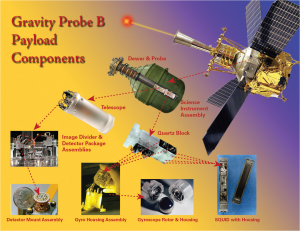Last week, while my attention was elsewhere (no one can prove I was watching KLF videos on YouTube), NASA announced the results of an EPIC space-time experiment. The World of Warcraft language is all theirs, but I have to admit that EPIC is an appropriate descriptor in this case. According to analyses of data returned by Gravity Probe B (GP-B), Einstein was correct. The earth exists within a 4-dimensional space-time fabric that behaves precisely as predicted: the mass of the earth dimples space-time and the movement of the earth distorts the dimple, creating a vortex or swirl in space-time.
GP-B is a nifty little instrument. As the graphic below shows, the orbiting spacecraft encapsulates a 9′-tall, 650-gallon dewar flask (thermos) filled with cooled liquid helium. Before launch, the cigar-shaped probe was inserted into the helium along the central axis of the flask. The instrumental component of the probe is the Science Instrument Assembly (SIA), which is composed of a telescope and a quartz block housing four gyroscopes.
In 2004, the spacecraft, complete with SIA, was launched into a polar orbit 642 km (400 mi) above the Earth. After the satellite reached orbit, the telescope and the spin axes of the four gyroscopes were aligned with a pre-designated star. The goal was to keep the telescope aligned with the star for a year without making similar axial corrections to the gyroscopes. After a year, the (postulated) precession change of the spin axis alignment of the gyros would be measured in respect to the plane of orbit (the geodetic precession) and the plane of the Earth’s rotation (frame-dragging precession).
Scientists are interested in the geodetic effect because it is an effective measure of how far the Earth is warping its local space-time. The axial drift is incredibly small (0.041 arcseconds over a year, with one arcsecond equalling 1/3600th of a degree), but the fact that it was measured at all indicates that the axis was tracing the curves introduced into the fabric of space-time by the mass of the earth. Most simply, the measure of geodetic precession reflects the “dimple” in space-time.
Scientists are even more interested in the frame-dragging effect, however. The idea that massive celestial bodies drag their local space-time around with them as they rotate was proposed about ninety years ago, almost immediately after Einstein gave us his theory of general relativity. If it’s true that space-time is dragged a bit during rotation, we would expect to see evidence not of a perfect dimple, but more of a twist, like a small tornado. It works on paper, anyway, but we’ve lacked the ability to measure the drag.
Until Gravity Probe B, that is. This is actually the spectacular part: the design team managed to encapsulate the probe in a drag-free satellite that protected the gyroscopes from disturbance as it moved through the planet’s outer atmosphere. Moreover, they designed a device that measured the spin of the gyroscope without actually touching the them (which would have disturbed their motion and made the results useless). While the results might indeed be EPIC, I have to admire the design process even more. Sometimes it can be difficult to get three people in the same room working collaboratively. Gravity Probe B comes to you courtesy of teamwork between NASA, Lockheed Martin, Stanford University, and King Abdulaziz City for Science and Technology in Saudi Arabia. That is EPIC, indeed.
Read more on the Gravity Probe B technology here and here. Check out the GP-B in a Nutshell posters for explanatory graphics
